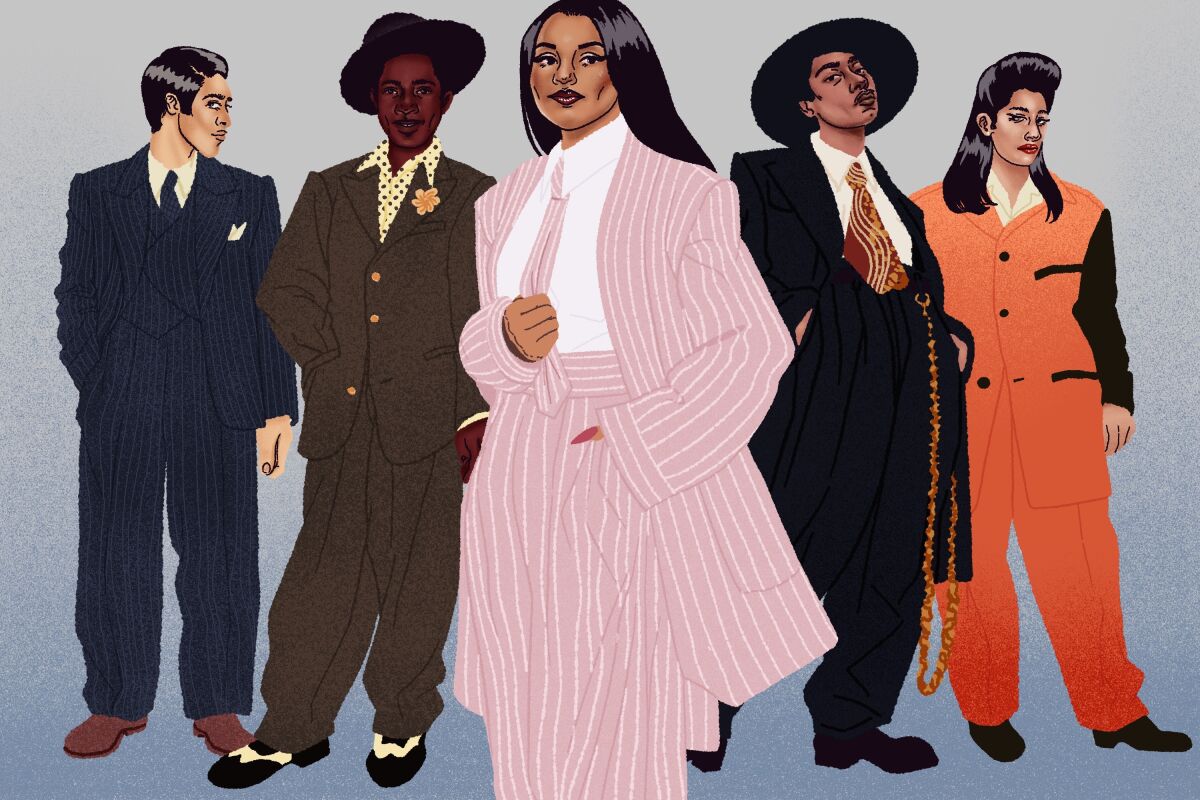Good morning, and welcome to the Essential California newsletter. It’s Monday, June 26. I’m Steve Padilla, editor of Column One, The Times’ showcase for storytelling. This month marks the 80th anniversary of one of the most shameful events in L.A. history — the Zoot Suit Riots — and that’s gotten me thinking about something my father once told me.
Dad grew up in Boyle Heights, and like lots of Mexican American boys and young men in the 1940s, he really wanted a zoot suit — those flashy outfits with tapered, high-waisted pants, fingertip coats and dashing hats, preferably graced with a feather. No way, said his mom. Good thing too. During the chaos of what became known as the Zoot Suit Riots, Dad saw sailors descend on a young zoot suiter, beat him and strip him of his clothes. Such scenes played out again and again throughout Southern California in June of 1943.

(Rachelle Baker / For The Times)
The riots were an extreme expression of a wartime fear of what was perceived as foreign and different, my colleague Christian Orozco explained in a detailed timeline enhanced with archival photos.
The zoot suit had crossed racial and ethnic lines — Black and Filipino young men wore them too, along with some white Angelenos — but rampaging crowds of sailors, other servicemen and white Angelenos targeted Mexican Americans in their determination to clear the streets of the guys in “freak suits.”
Sadly, “freak suits” is just one of many unfortunate word choices the L.A. Times made about the suits and those who wore them. “Gamin’ dandies,” they were called. “Hoodlums” was another favorite term. We weren’t the only newspaper to demonize pachucos or promote violence; radio stations piled on too, even broadcasting where the night’s mayhem was expected to happen. As a fellow Times editor, Shelby Grad, pointed out, the riots amounted to state-sanctioned chaos, and by “state” he meant the media, military, business community and local governments. Such complicity underscores the significance of recent resolutions by the Los Angeles County Board of Supervisors and Los Angeles City Council, which denounced the violence and apologized for their role in the unrest.
The legacy of the riots has never really left the consciousness of the Mexican American community, but the riots remain largely unknown to the public.
I mentioned my dad and his unfulfilled desire for a zoot suit. Reporter Louis Sahagún told me that his father wanted one too and was more successful. Sort of. Louis’ dad saved up and bought a set of “drapes,” as they were called. When his father discovered the zoot suit, he promptly took out a pair of scissors and cut it up.
ADVERTISEMENT BY CITY NATIONAL BANK
 City National Bank® stands proudly on our legacy of corporate philanthropy and a commitment to the communities we serve. For nearly 70 years, our commitment to people and relationships has remained the starting point for everything we do. We're here to help you navigate life's most significant decisions so that you feel empowered to build a financial foundation for future generations.
Stepping through the doors of a new home starts with financial education. We understand that navigating finances is challenging. That's why we're dedicated to providing educational resources to help simplify your path to homeownership.
Learn more cnb.com/TheWayHome
|
|
More about the riots
Zoot suit: How the bold look made history and continues to influence fashion. Carolina A. Miranda took a deep dive into zoot suit culture and fashion, tracing the suit’s origins to Harlem, where it was popular among African Americans. Carolina also shared an unexpected fact: how the suit’s basic contours could be linked to designs favored by a future king of England.
The untold story of how Black L.A. defended Mexican Americans during the Zoot Suit Riots. The riots are often portrayed as a conflict between white and brown L.A. My colleague Gustavo Arellano’s surprising and inspiring story of how leaders of L.A.’s Black community defended the zoot suiters is all the more relevant, he wrote, given the racist remarks Latino leaders made about the Black community in last year’s infamous recording.
- Gustavo talked about the riots on KQED. I’m on the show too, but you’ll really want to hear from Gustavo and Elizabeth Escobedo, an associate professor of history at the University of Denver and author of “From Coveralls to Zoot Suits: The Lives of Mexican American Women on the World War II Home Front.”
By exploring L.A.’s racial injustice, Luis Valdez’s ‘Zoot Suit’ gave birth to Chicano theater. I may have learned about zoot suits and the riots from Dad, but many Angelenos, including members of the Mexican American community, were introduced to those dark days by Luis Valdez’s groundbreaking play “Zoot Suit.” Times reporter Reed Johnson chatted with Valdez on the play’s origins, legacy and lasting impact on Chicano theater. He also interviewed the original El Pachuco himself: Edward James Olmos. I confess to being jealous about this because Reed got to hear Olmos recite his original opening monologue. (Reed, you couldn’t conference call?)
No comments:
Post a Comment